DIY: Painting A Checkerboard Floor (Tips + Products I Used)
As of last night, I’m about halfway done with painting a checkerboard floor in the studio. Here’s how it looks so far…
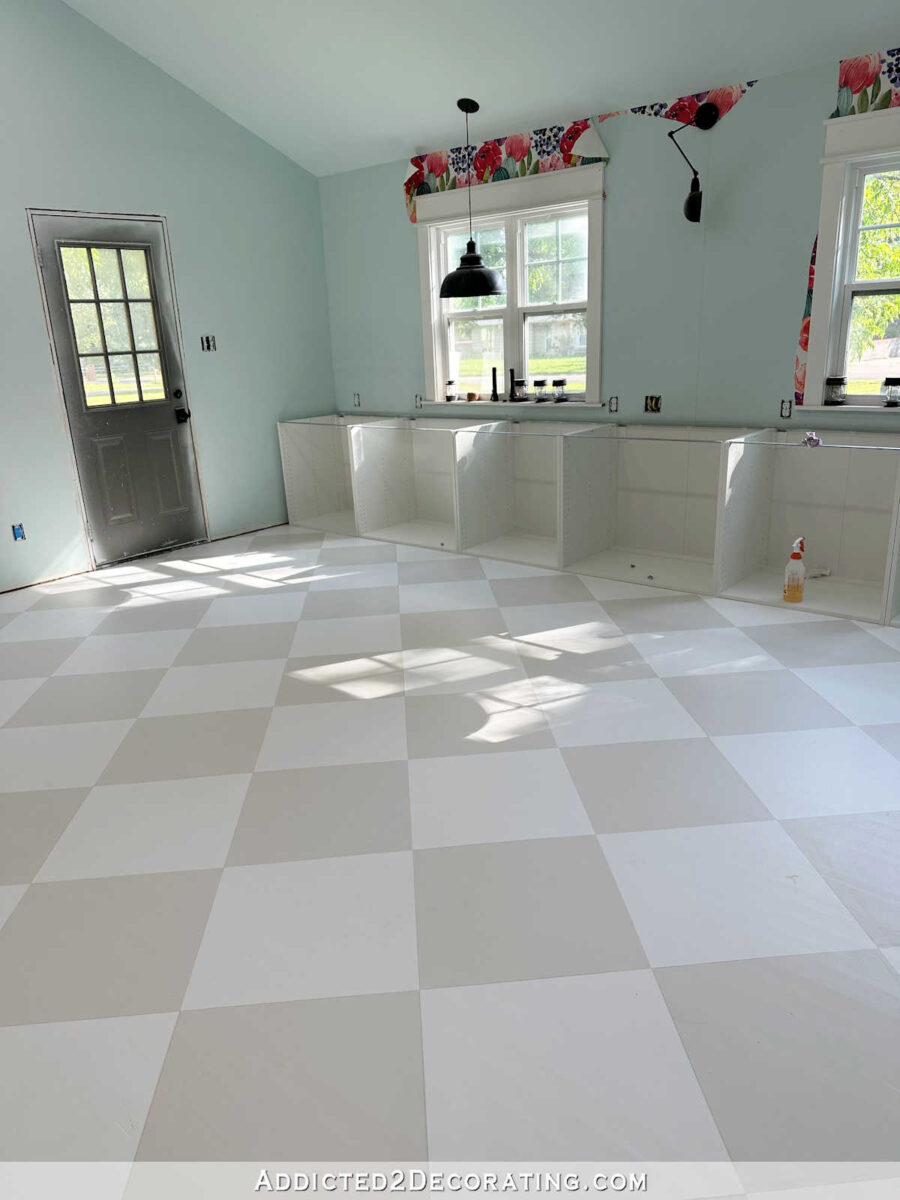
I’m really pleased with how it’s turning out so far. The main room, which is about 19.5′ x 21′, is about 2/3 finished. So now I have to put protective paper down on this finished area, move my big rolling work tables and other items to this side of the room, and then start on floors in the rest of this room, the back entry, the storage closet, and the bathroom.
The floor in this room is red oak hardwood flooring, and since this is a studio where I’ll be using paint, resin, alcohol inks, etc., I wanted a floor that could very easily be spot sanded and retouched when I drip things on the floor. Paint seemed like the obvious answer. So let me show you how I did it.
I started by sanding the floor to give the previous finish some “tooth”. Hopefully this will give the paint and primer more durability than it would have had I painted right over the slick water-based polyurethane floor without sanding first.
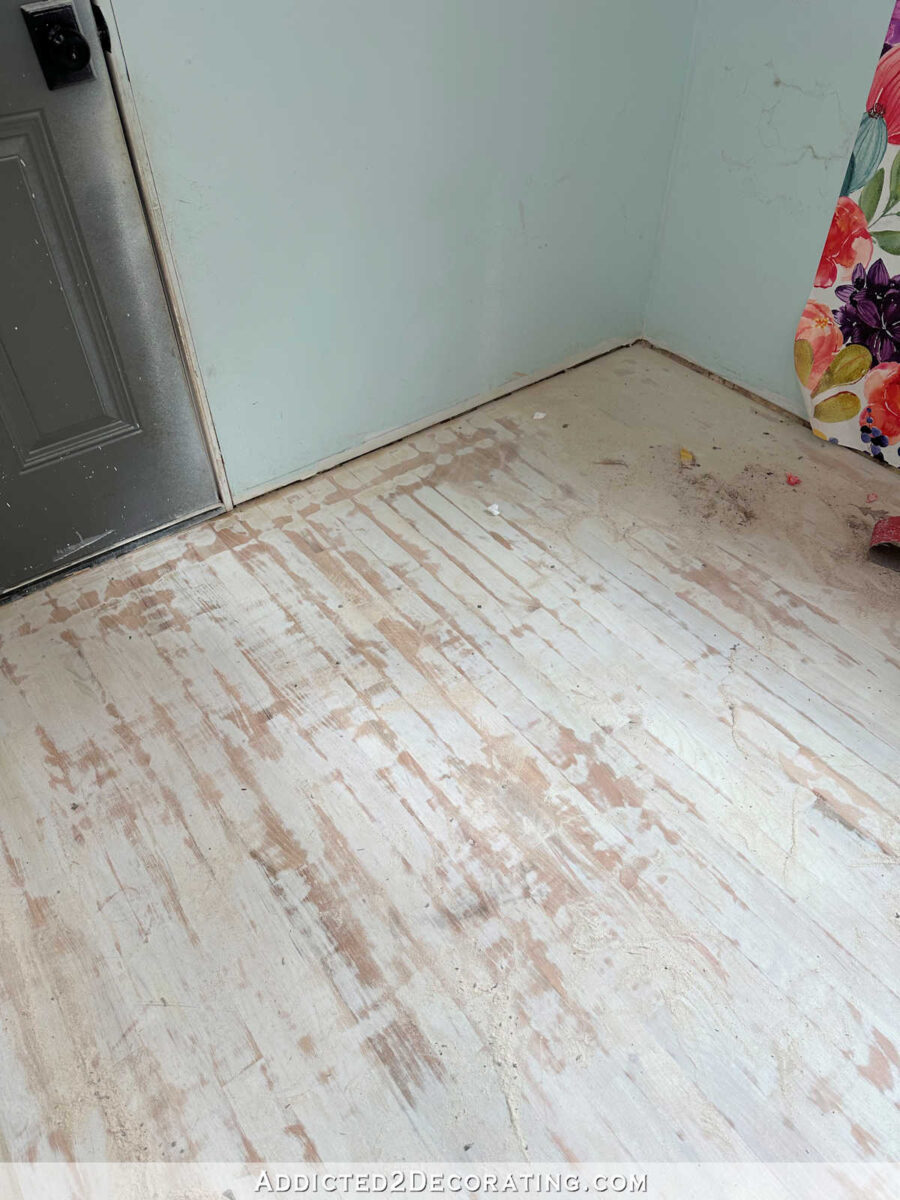
Some floors probably wouldn’t have to be sanded quite that much, but I was also trying to get rid of some water damage and other imperfections in the floor, so I did a little more sanding than was probably necessary (because I’m a perfectionist).
Then I gave the floor two coats of Zinsser B-I-N Shellac-Based Primer. This was only my second time using this product, but after getting used to the thin consistency, I was very pleased with how it performed the first time I used it (on my front porch ceiling), so I decided to stick with it on this project as well.
And then I gave the floor two coats of paint, which I rolled on using a 3/8-inch nap roller (these are the ones I use). And because the floor is a very large area, I used a standard roller than you would use to paint a wall. The paint I chose to use is Behr Porch and Patio Floor Paint in the low-luster finish. I started with the darker color, which is Benjamin Moore Classic Gray, which I had them color match in the Behr paint.
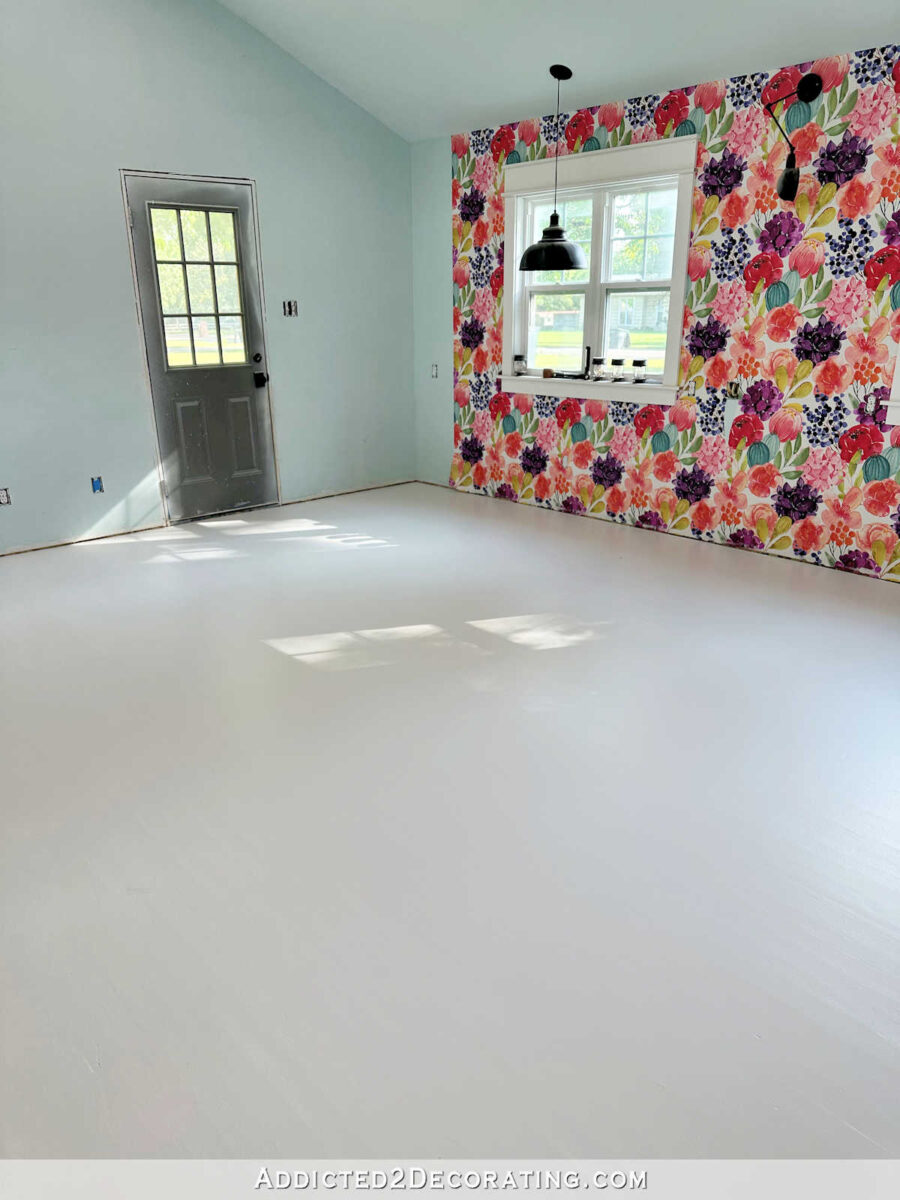
I let that dry for about 36 hours while I put my cabinets together and put them into place along the front wall of the studio. I wanted to put the cabinet in place first because the cabinets aren’t perfectly centered on the wall since the windows aren’t perfectly symmetrical on the wall. And I’d rather have the checkerboard floor design centered on the cabinets rather than being perfectly centered in the room and slightly off with the cabinets.
So once the cabinets were in place, I measured and marked the center of the middle cabinet using my tape measure and a pencil, and then continued marking the rest of the floor using that same measurement, using a straight edge (a framing square) until I had a line drawn perpendicular to the center point on the middle cabinet.
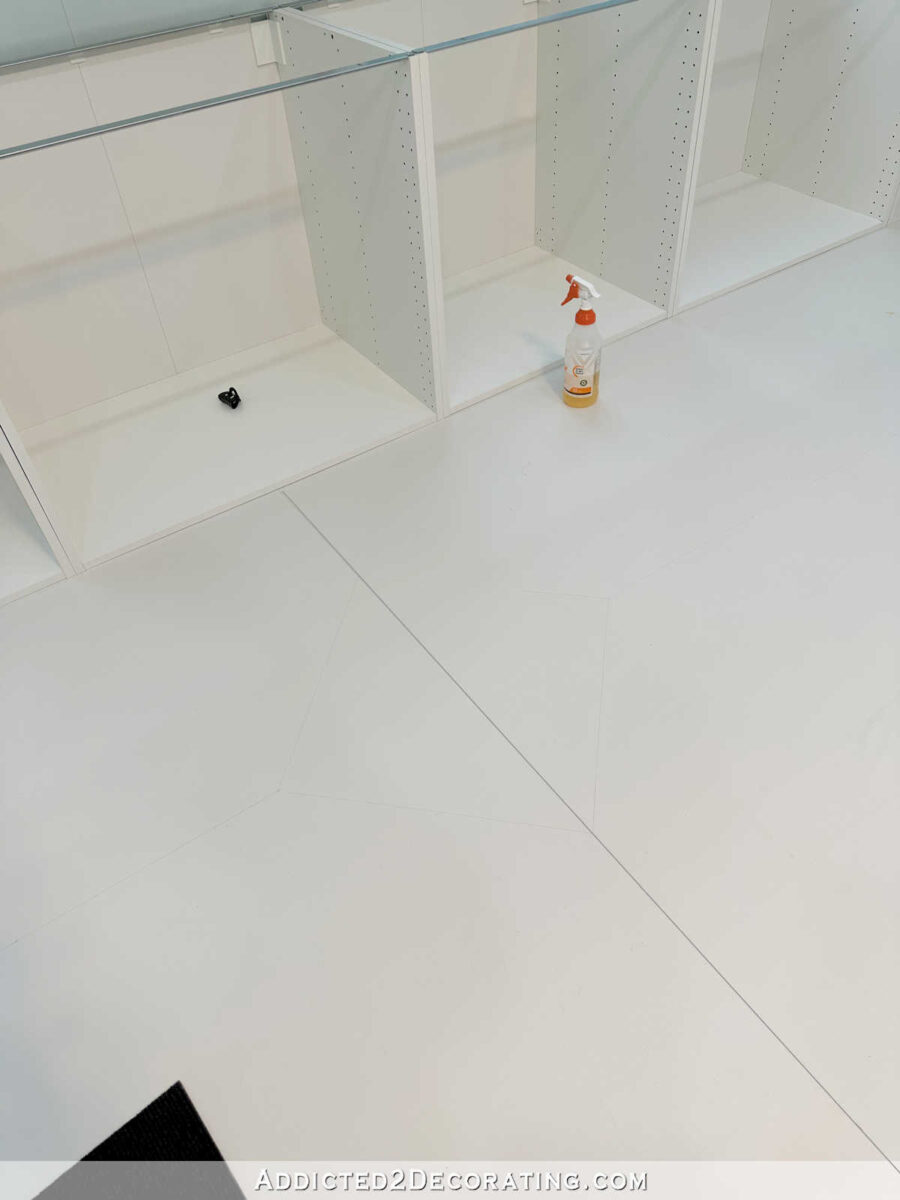
Next, I used my square pattern (I used a leftover FLOR carpet tile as my pattern, but you can cut a pattern out of cardboard, poster board, etc.), and lined up two points perfectly along that line close to the cabinets, and traced the square.
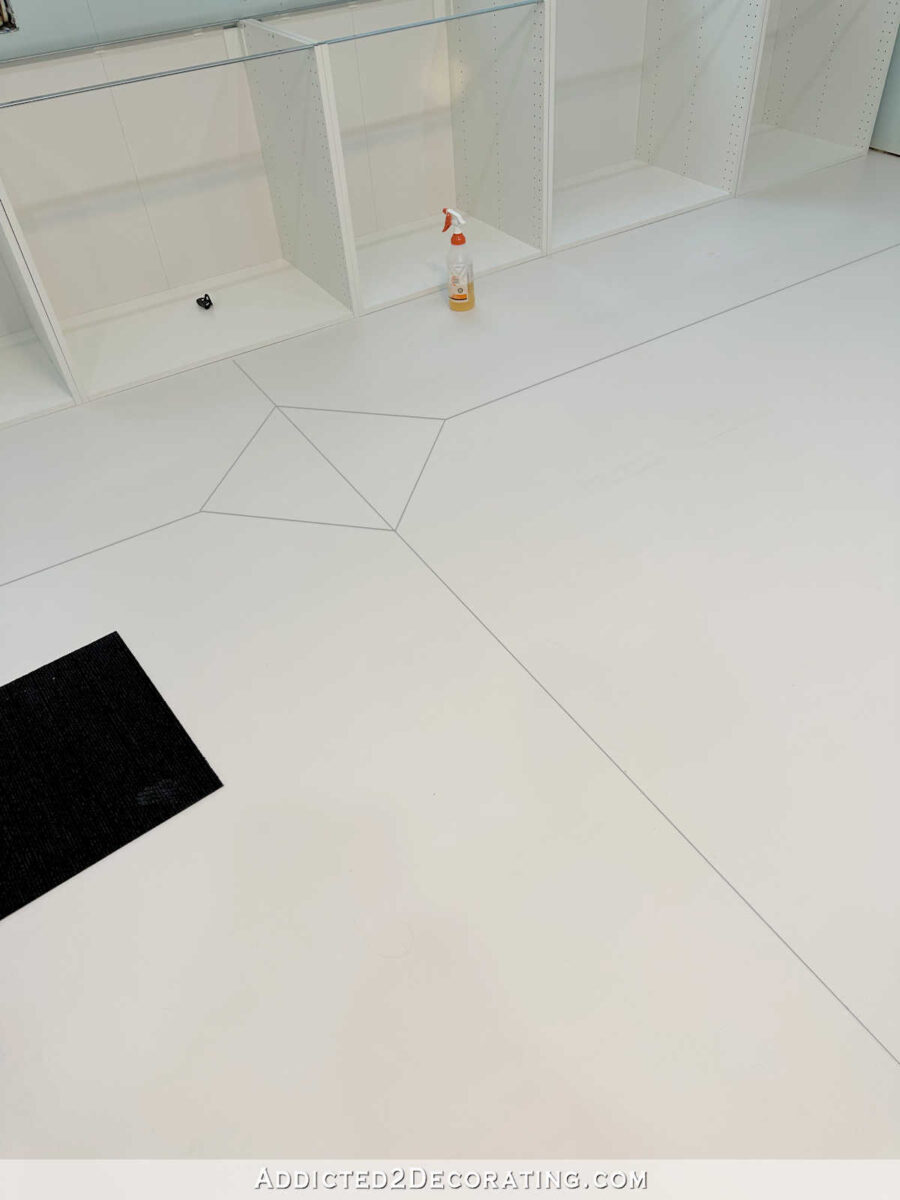
Then using the other two points on the square, I used those as my guide to measure and mark a line equidistant from the cabinets that ran parallel with the cabinets. Again, it was more important to me that the checkerboard design looked right with the cabinets rather than it being perfectly centered in the room. Rooms are almost never perfectly square, so if the design was slightly off in another area, it would be way less noticeable than it would be if the design was off with the cabinets on the main focal wall of the room.
Once I had that line drawn parallel with the front of the cabinets, I then used my square pattern (the carpet tile) to continue the pattern on that parallel line.
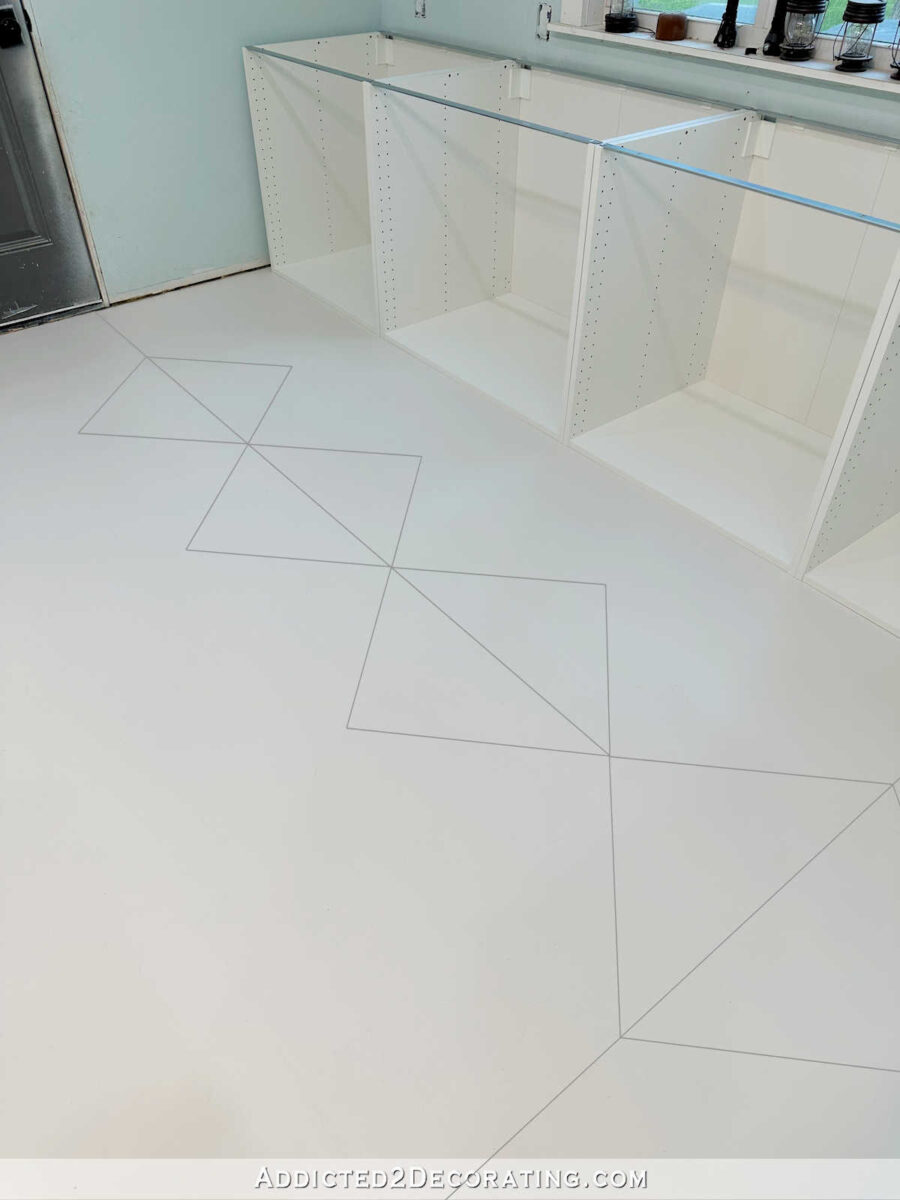
Once I had the squares traced on the center perpendicular line and the all across the parallel line, I went back and easily fill in the rest of the squares using my pattern.
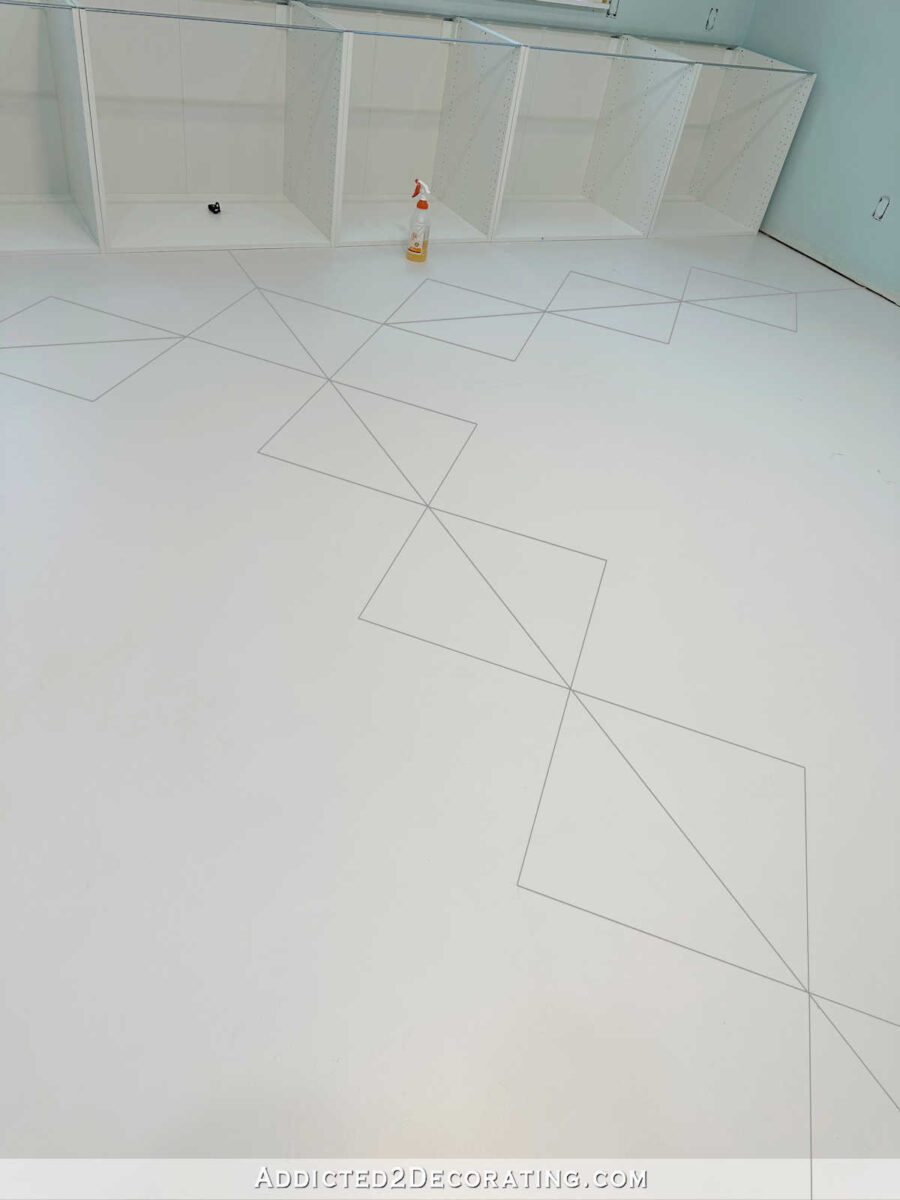
When I had all of the squares traced, I used painters tape to mark off all of the squares that would be painted my contrast color (Behr Polar Bear), and then I began taping off the squares to be painted. It’s not efficient to try to tape off every single square to paint them all at once. It’s much easier to tape off every other one and paint those, and then when those are dry, to go back and tape off the rest and paint those.

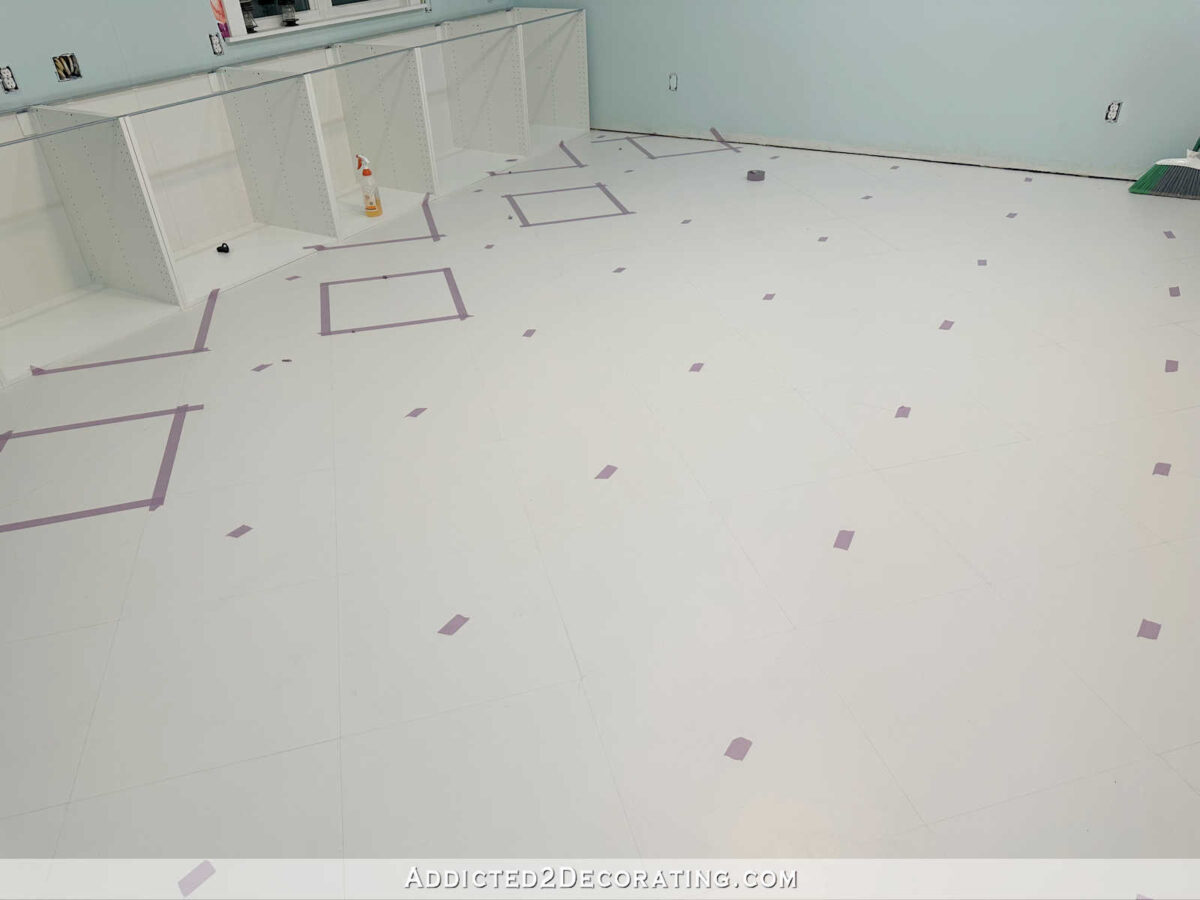
So once I had the first batch of contrast squares taped off and ready for paint, this is what the floor looked like. Note that I used painters tape specifically for delicate surfaces since the original coat of paint (the Classic Gray) was still pretty fresh.
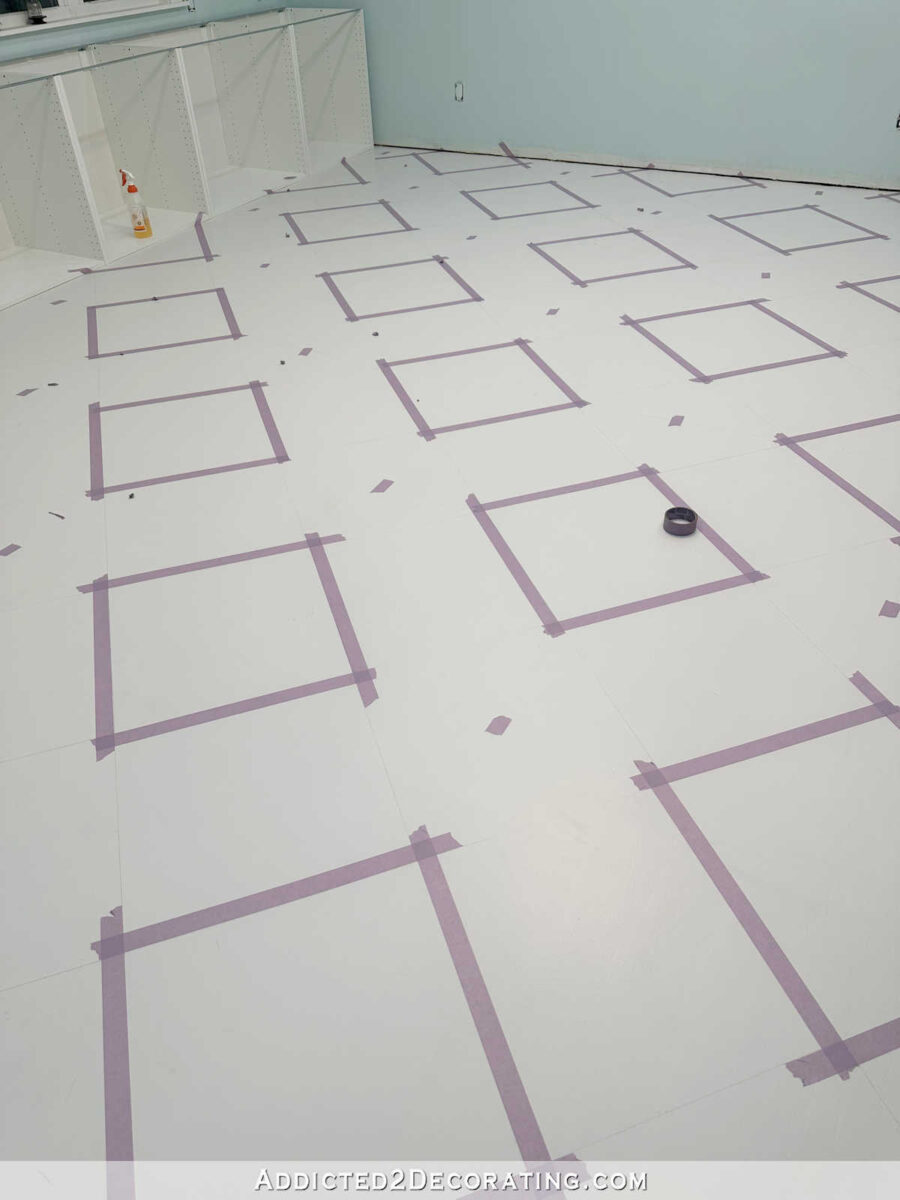
Before I could paint, I first needed to get rid of any pencil marks. Pencil marks will bleed through paint, so it will save you a huge headache to get rid of them instead of trying to paint over them. And don’t ever try to erase them with a pencil eraser or even a quality art eraser. Those will just smudge the graphite on paint, and leave you will a mess. I always get rid of my pencil marks using a Magic Eraser. They work so fast and make easy work of removing pencil marks. And I didn’t just remove the pencil marks going through the middle of some of the squares, like the one you see here…
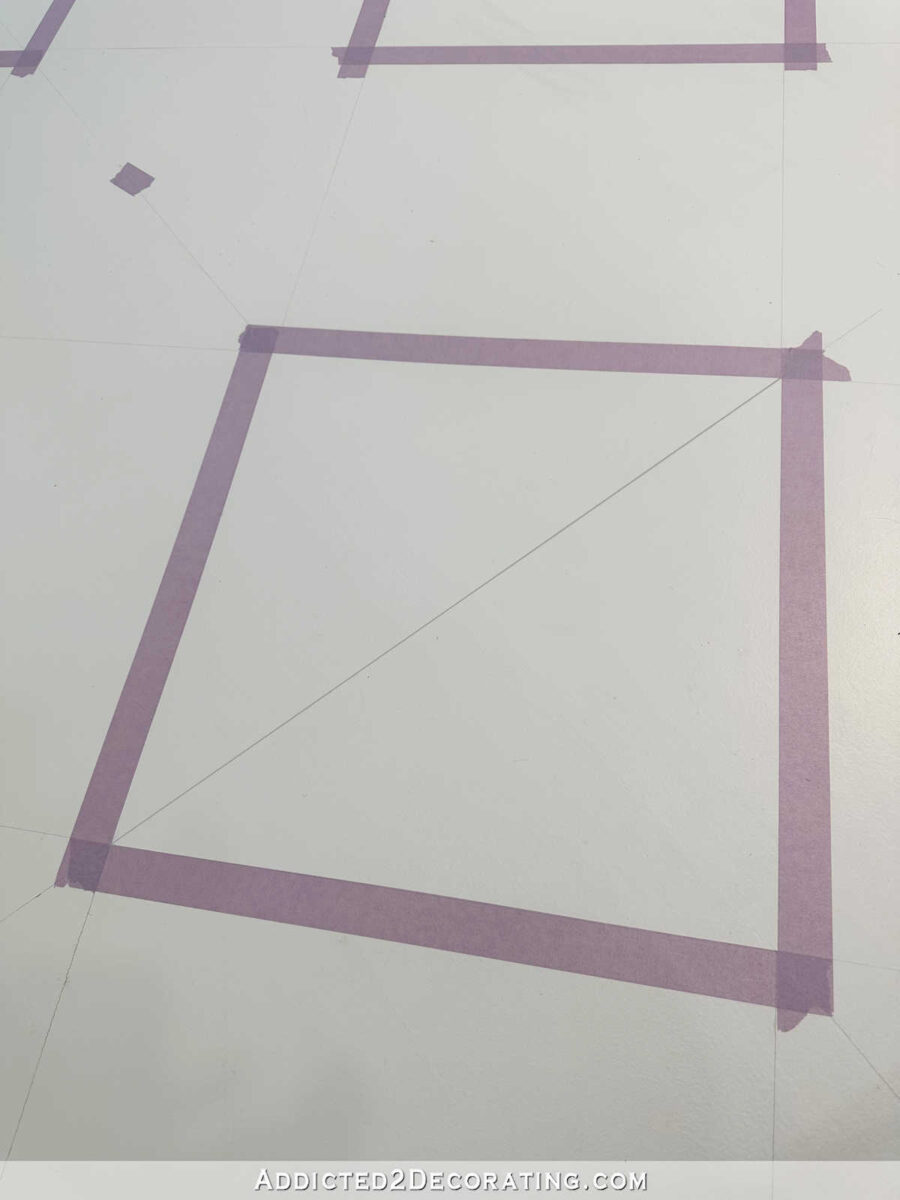
But I also removed the marks along the taped edges. That way I can get rid of pencil marks and burnish the tape so that it’s stuck really well to the floor all in one quick step. You can see how well the Magic Eraser removed the marks from the same square pictured above…
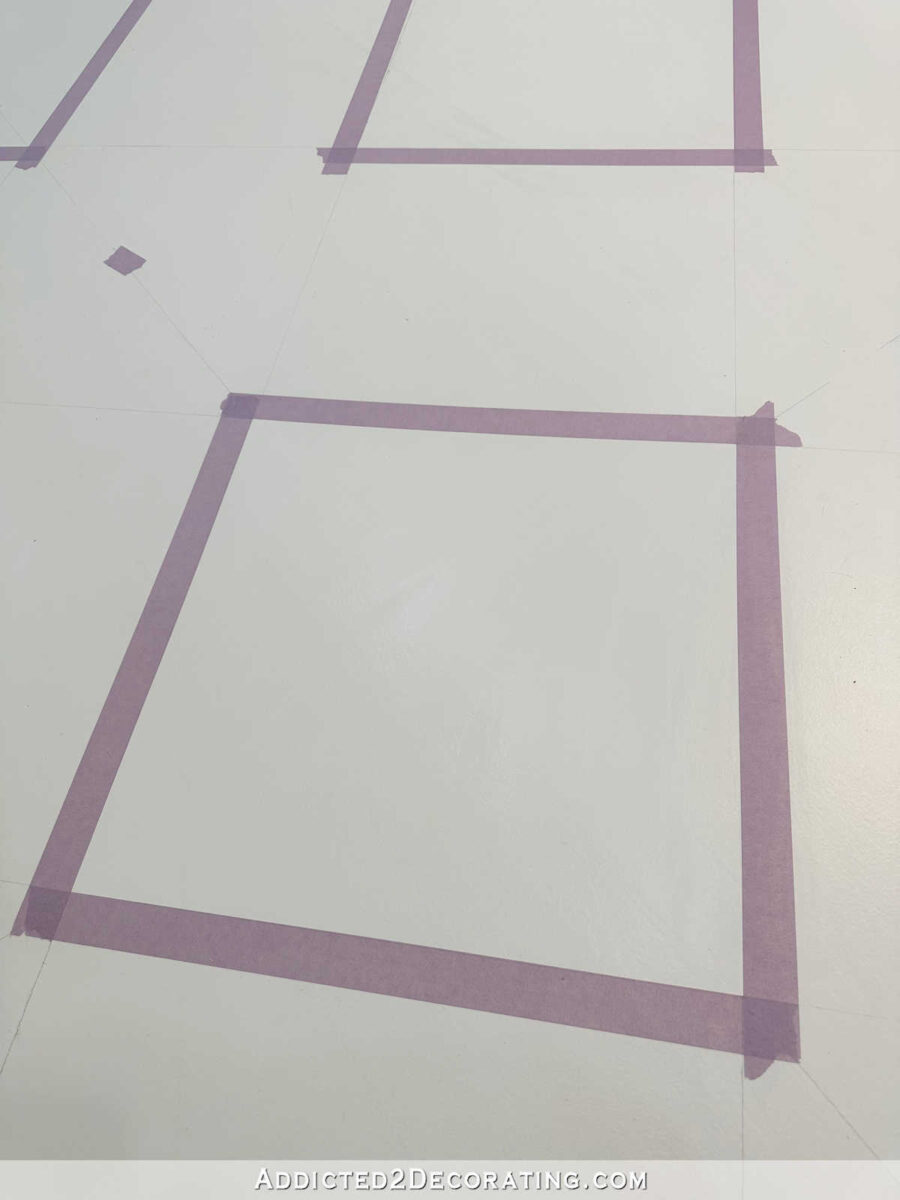
And then I did one more step before painting the squares. Whether painting a checkerboard floor or painting stripes on a wall, I like to ensure that the edges of the contrast color will be perfect by sealing the tape with the original color (Classic Gray) before painting the contrast color (Polar Bear). By painting the floor first with Classic Gray, and then sealing the tape with Classic Gray, that means that if any of the paint used to seal the tape bleeds under the tape, it will just blend right into the original color and won’t be noticeable. But as it dries, it’ll seal the edges of the tape.
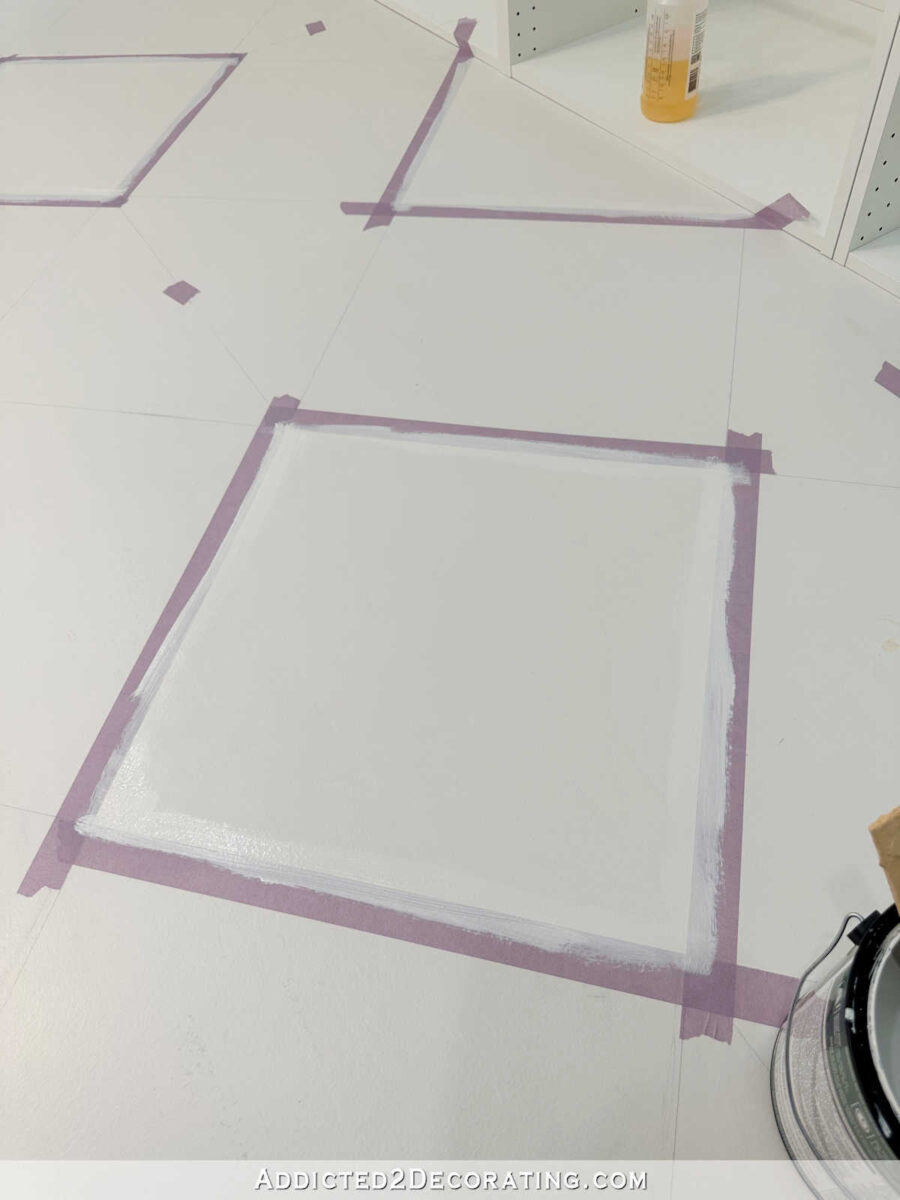
It didn’t take long at all for that to dry. In fact, by the time I finished the last square, the first squares were dry enough to paint. I painted the contrast squares using a 1/4-inch nap 6-inch roller for smooth surfaces.
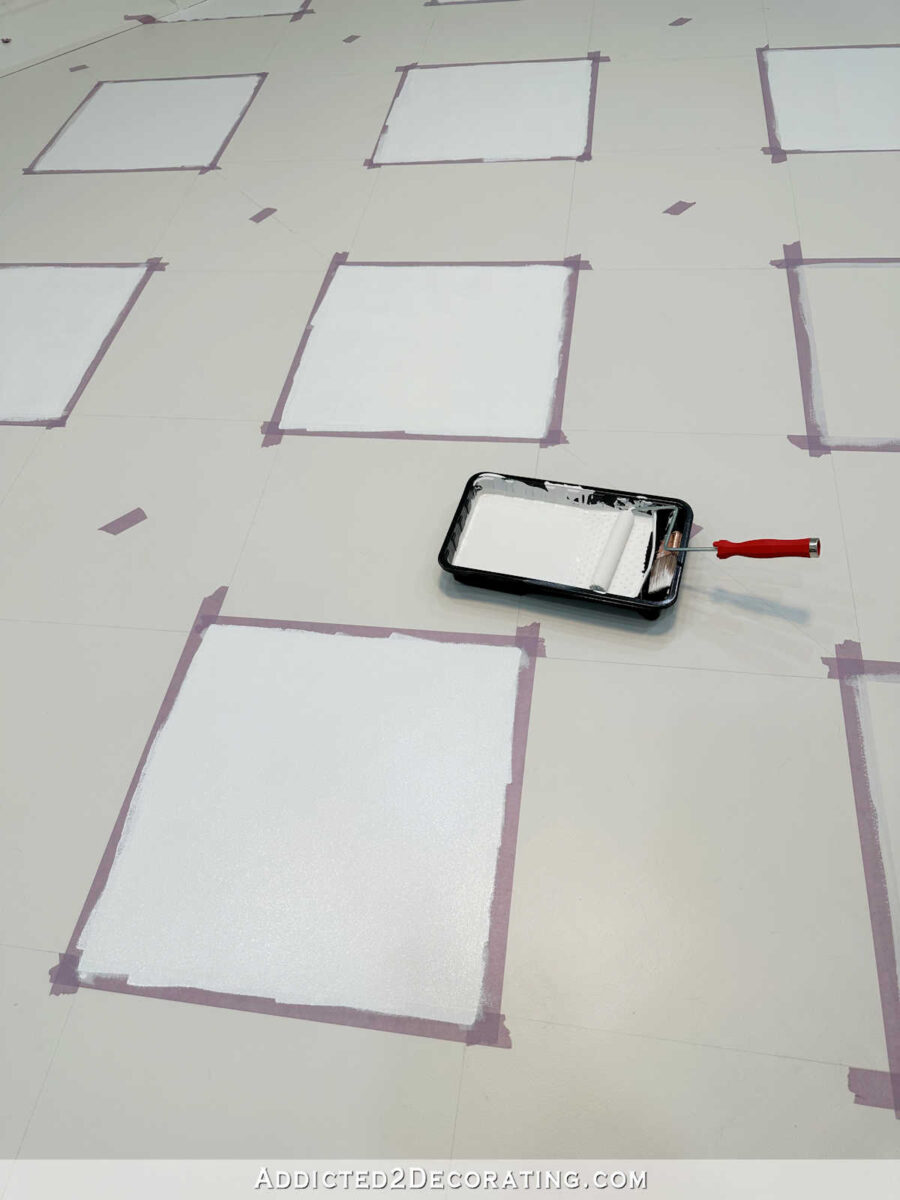
The marking, taping, erasing pencil marks, and sealing the tape are all the time-consuming parts of painting a checkerboard floor. By the time all of that is done, the actual painting goes very quickly. I gave the squares a first coat of paint, and then let them dry for about 40 minutes.
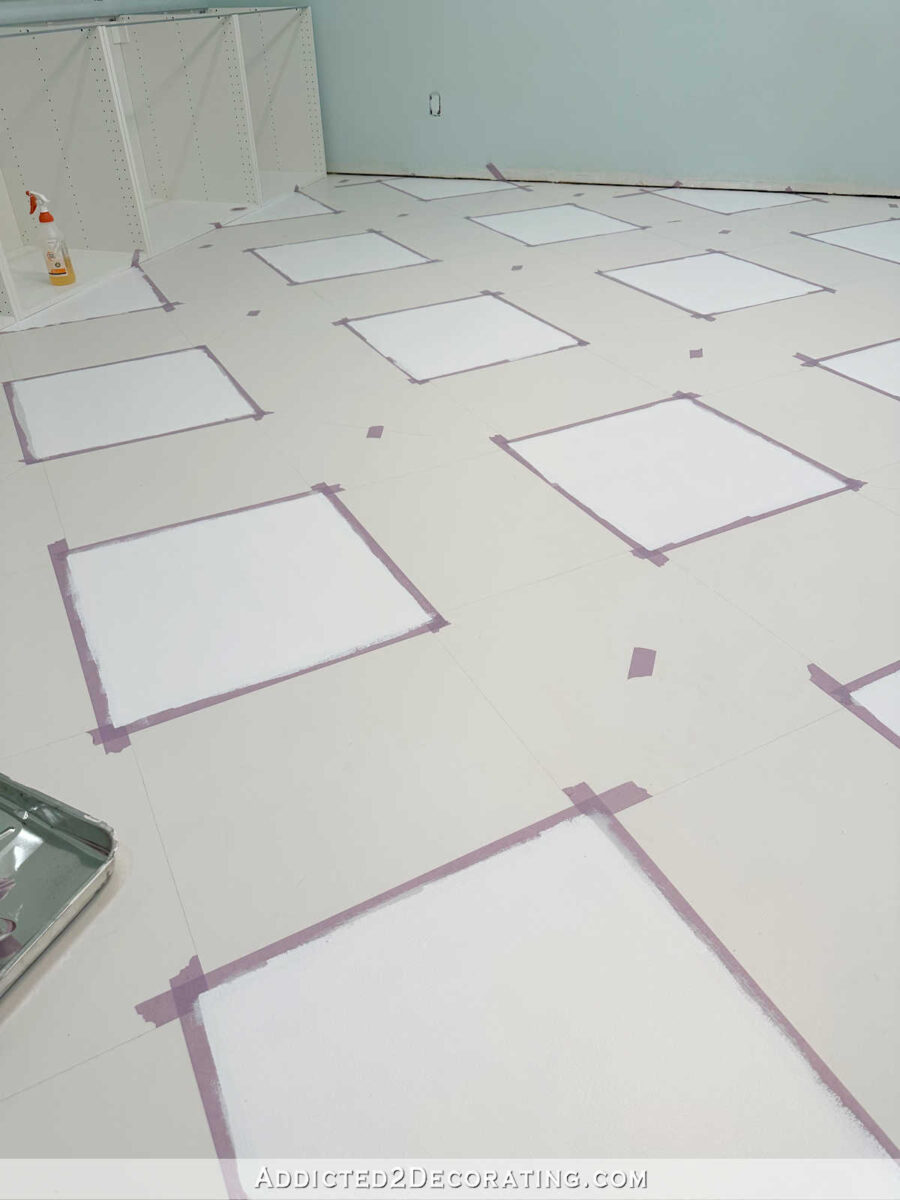
Then I rolled on a second coat. Immediately after painting the second coat, and while the paint was still very wet, I removed the tape. You can see how perfectly crisp the edges are…

I let that first set of squares dry for about 24 hours, and then I taped off the rest of the contrast squares and repeated that same process — removing the pencil marks, sealing the edges of the tape with the first color…
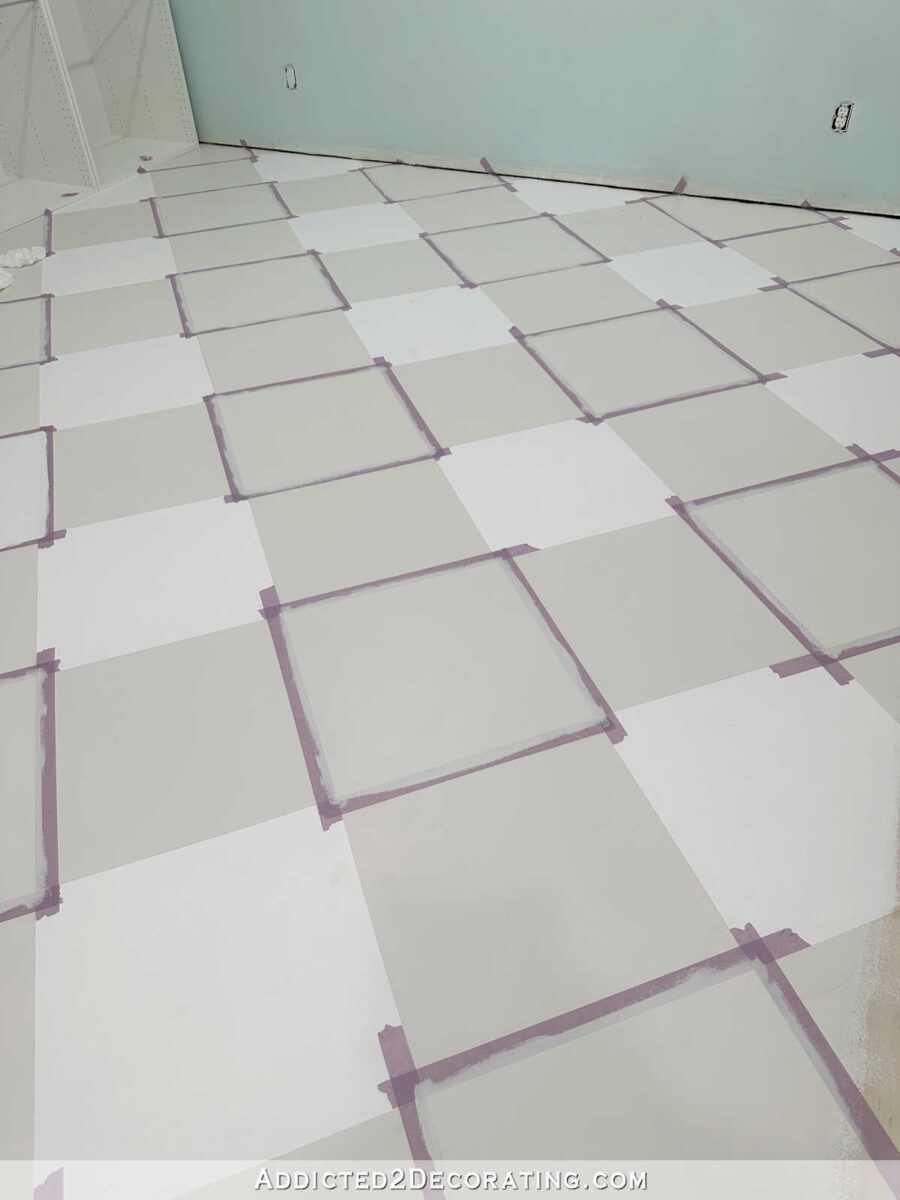
Followed by two coats of the contrast color, and removing the tape while the second coat was still very wet.
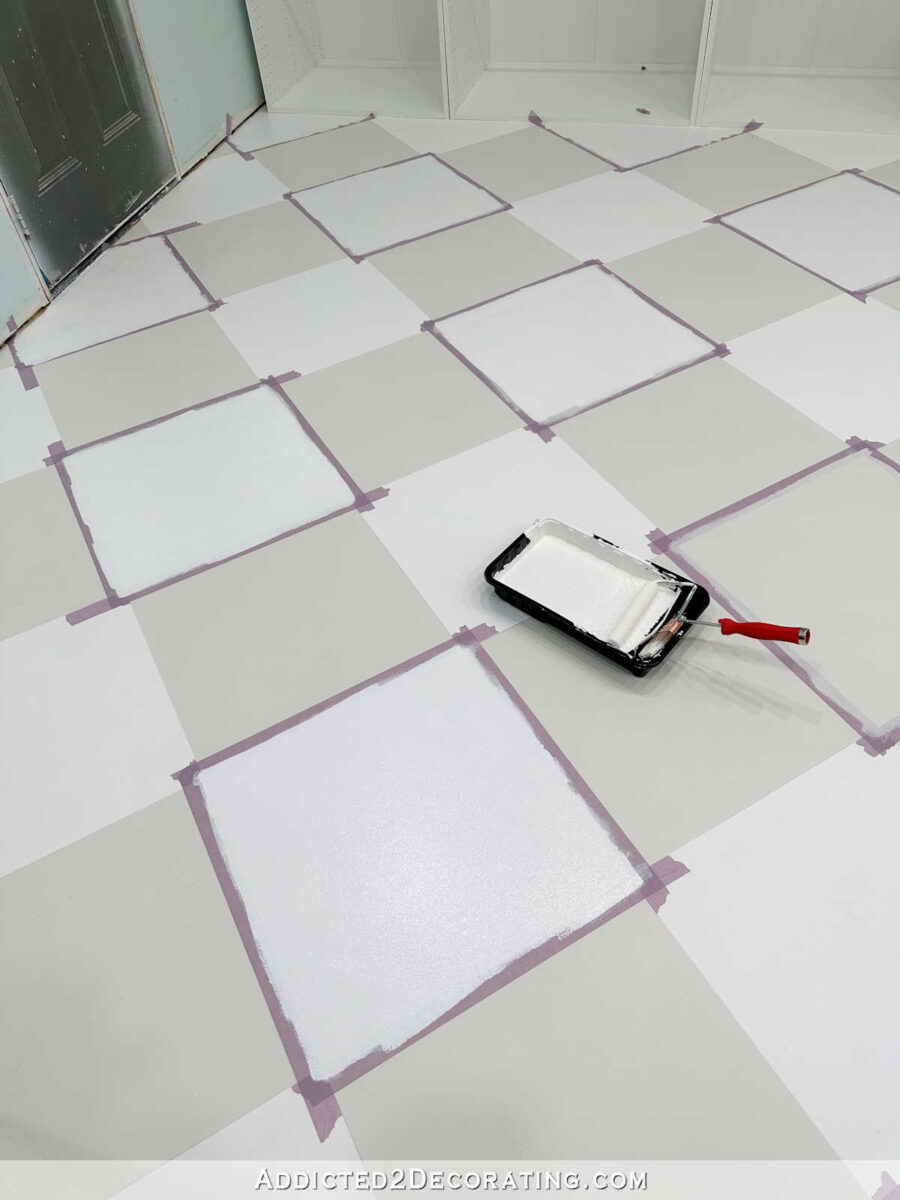
And there it is! My new painted checkerboard floor in my studio. I know it’s a brand new painted floor, and it hasn’t even fully cured (I think full cure takes about 30 days), but I’ve already been very impressed with the durability of this paint.
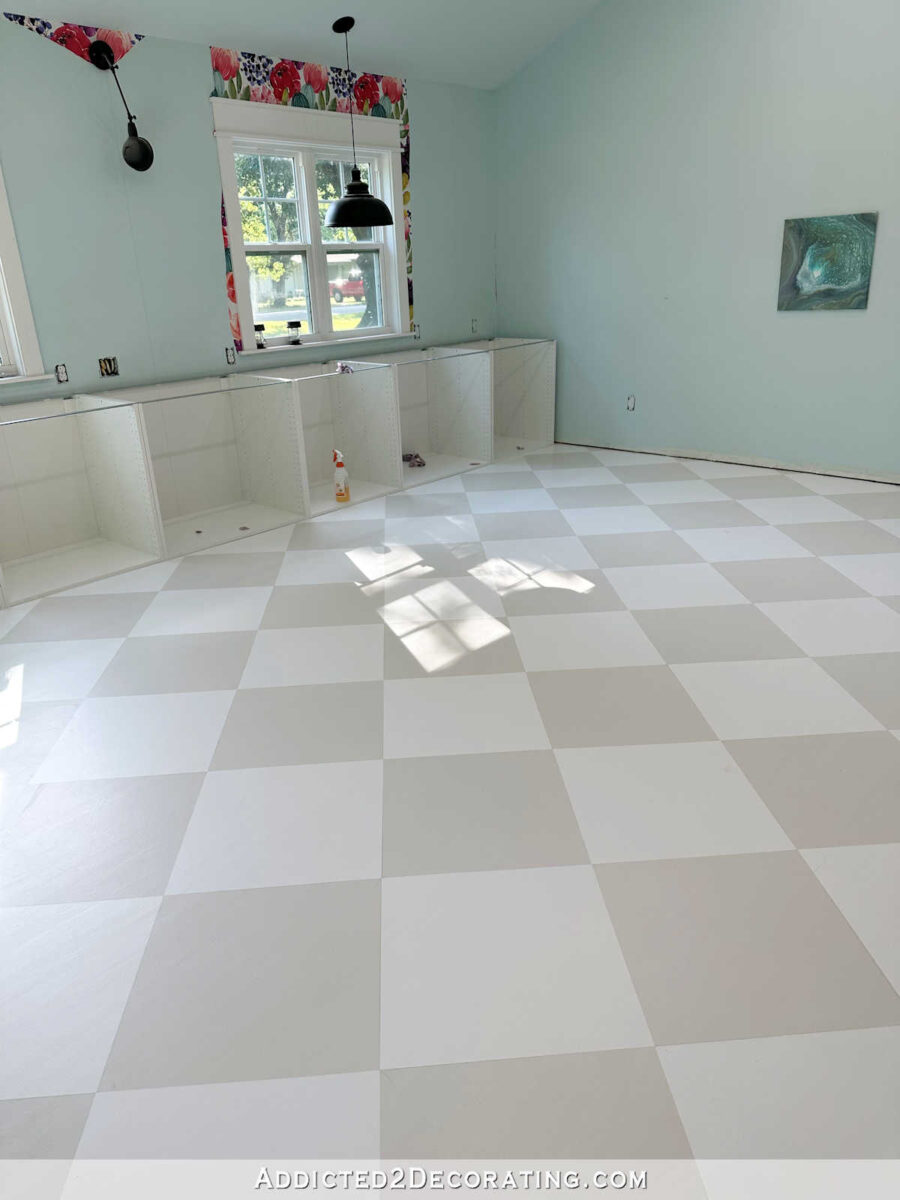
Cooper has even been in here (my hyper 100-pound dog who won’t let me touch his feet, so I can’t clip his claws), and the floor held up perfectly to his craziness.

I don’t plan to do a clear coat on the floor because that would just complicate the touch-up process, and would defeat the entire purpose and my reasoning for having a painted floor in the first place. So that means that once I get the rest of the pencil marks off of this side of the room (the pencil marks that were hiding under painters tape), I’ll be ready to put protective paper over this side of the room, get all of my stuff moved over to this side, and get started on the rest of the floor. It’s been a slow process, but at least I’m making progress! And truth be told, while painting a checkerboard floor is a lengthy process, the difficulty level is quite low. It’s been a fun and satisfying DIY project to take on.
Addicted 2 Decorating is where I share my DIY and decorating journey as I remodel and decorate the 1948 fixer upper that my husband, Matt, and I bought in 2013. Matt has M.S. and is unable to do physical work, so I do the majority of the work on the house by myself. You can learn more about me here.


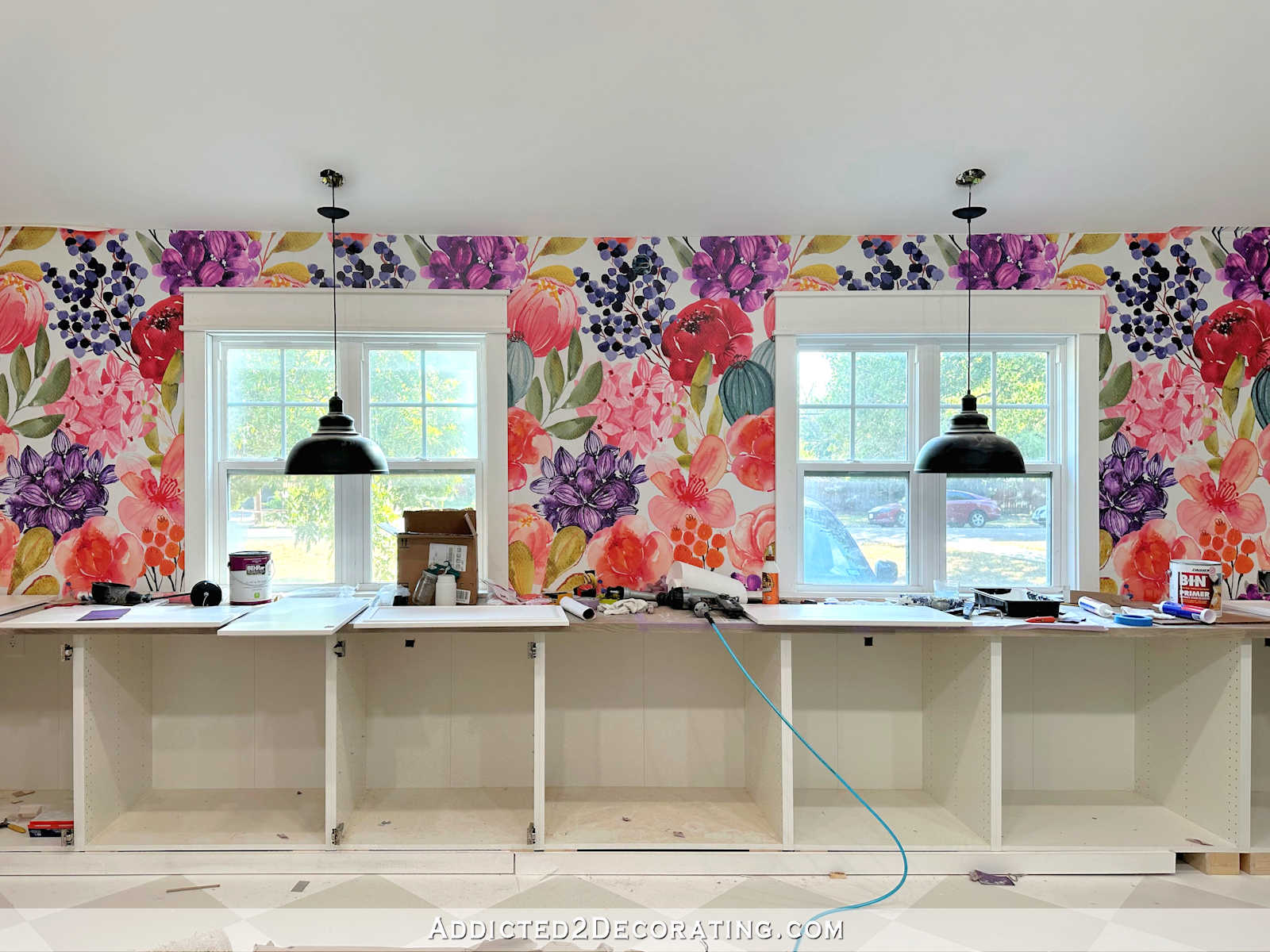
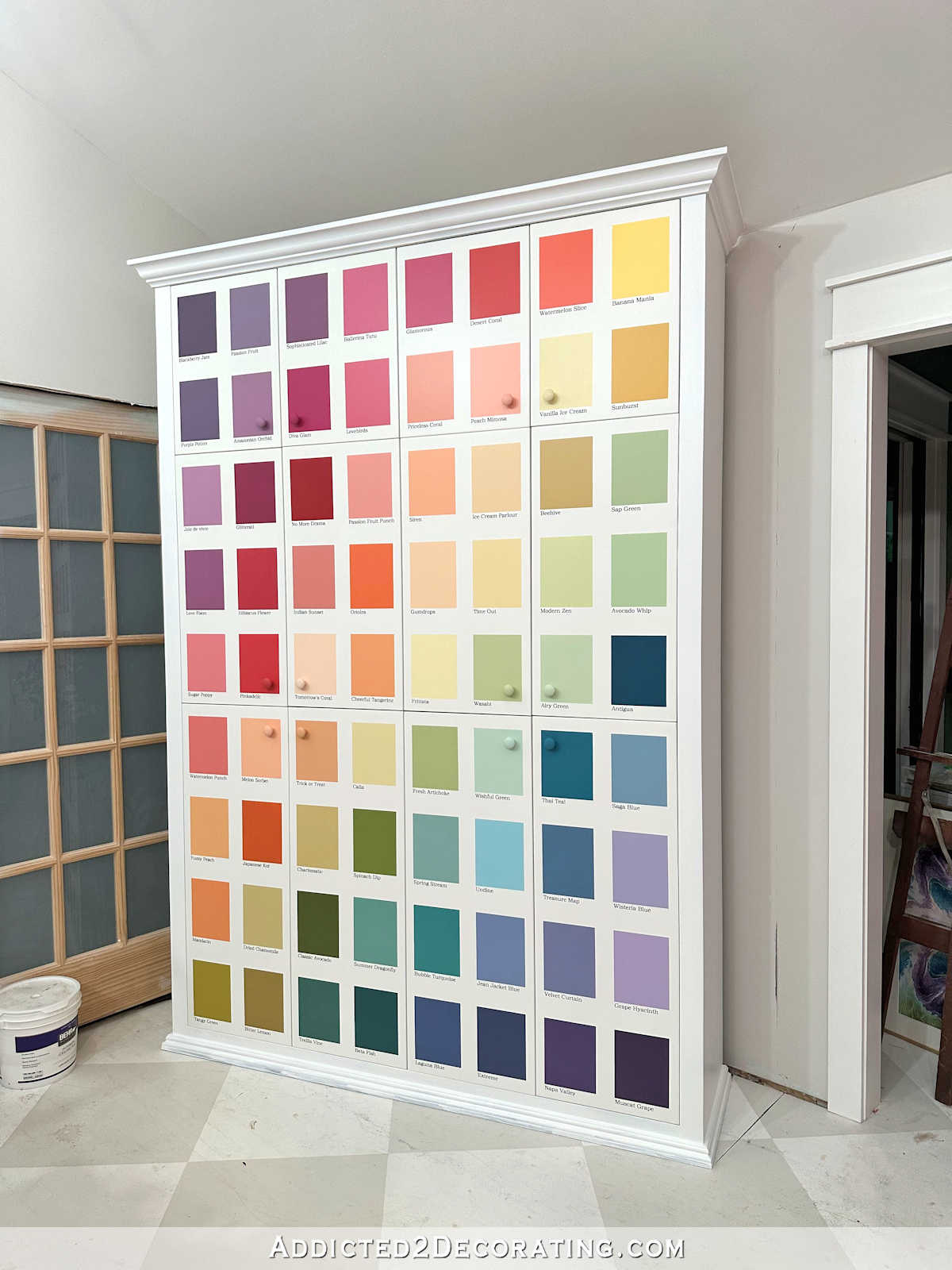
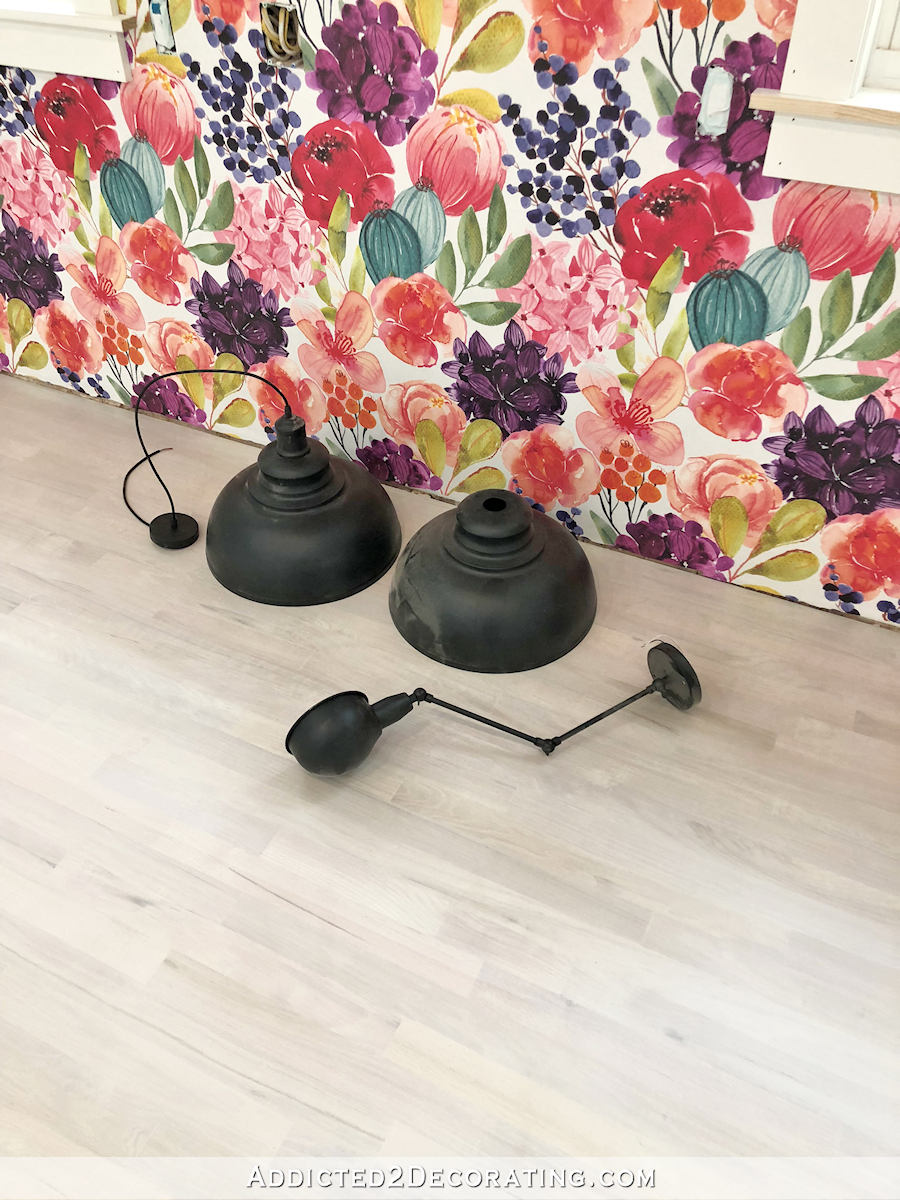
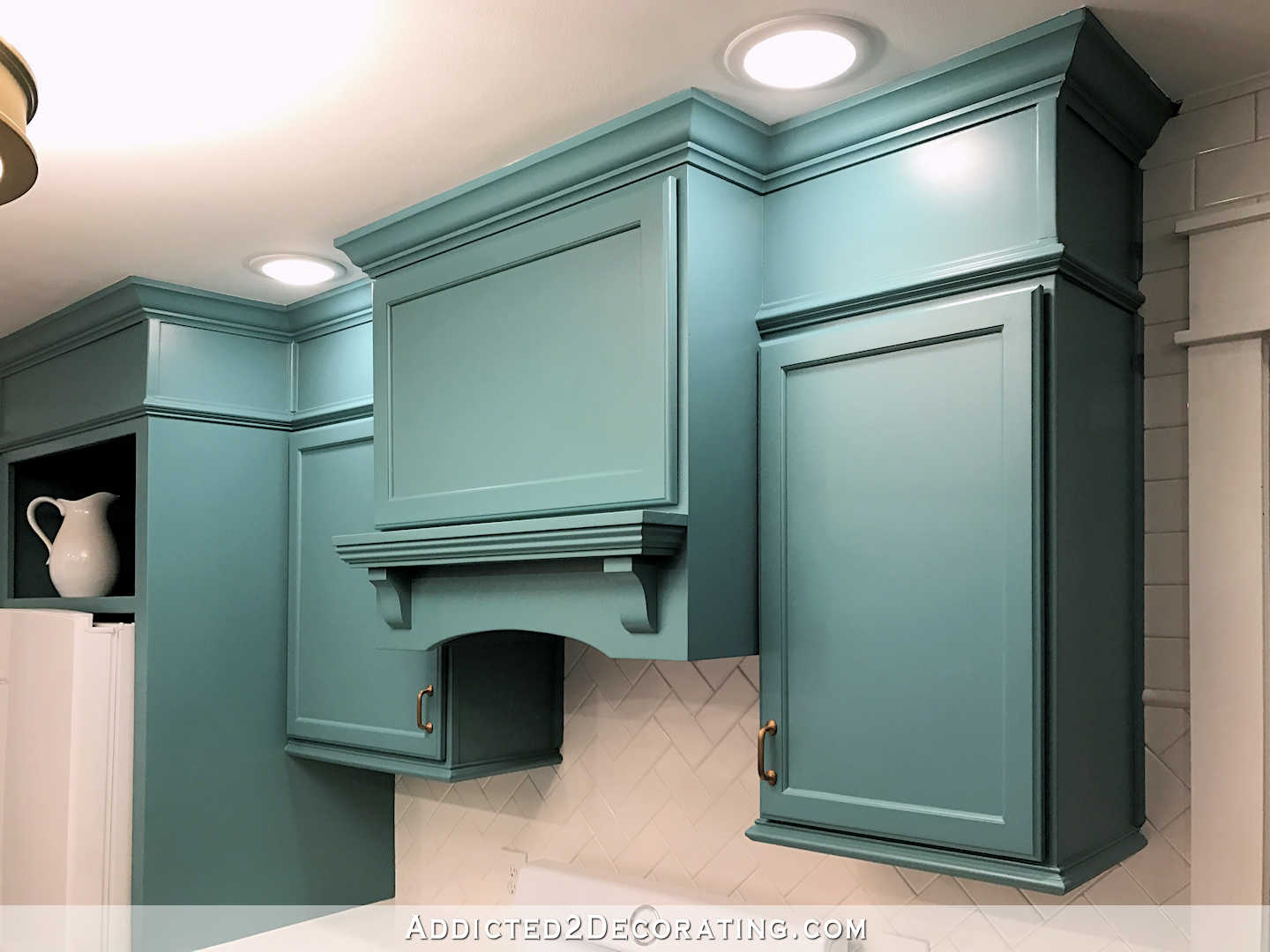
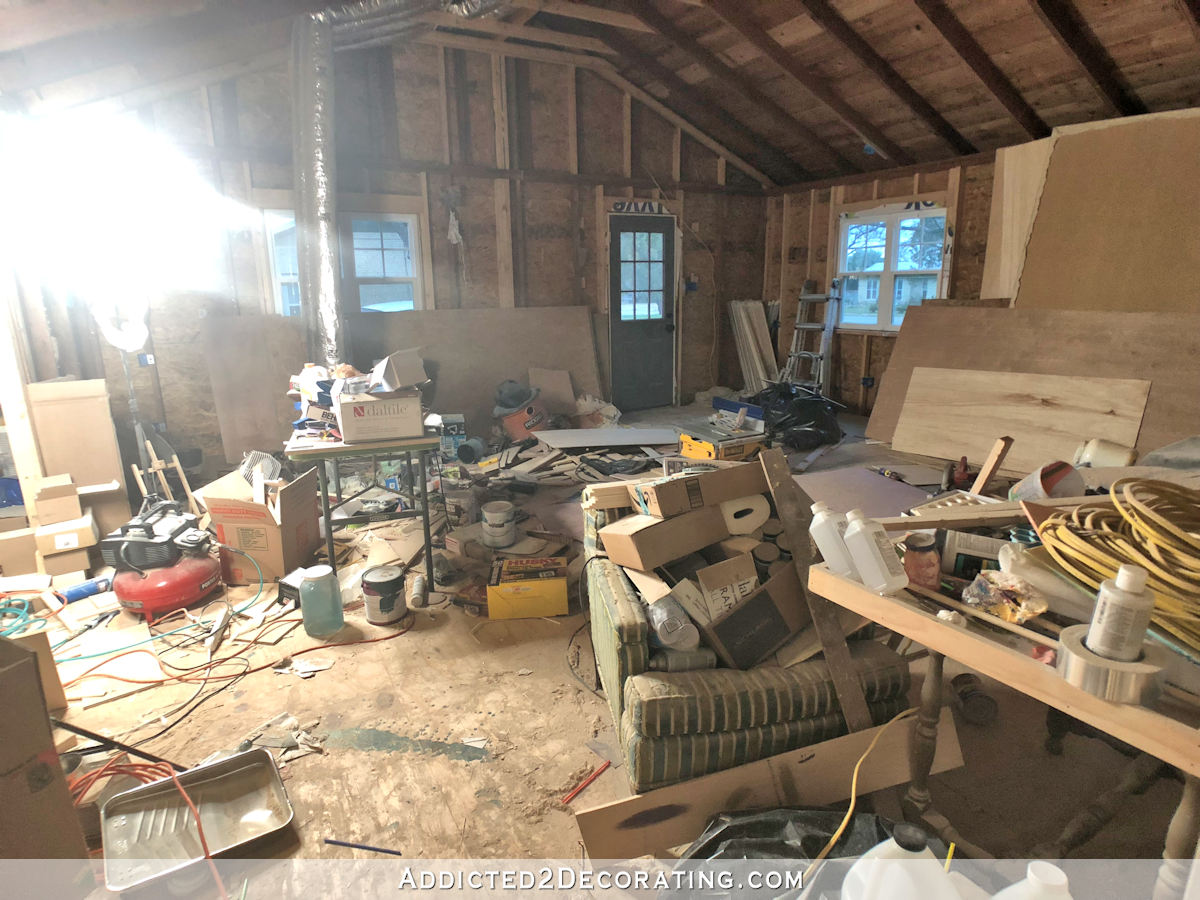
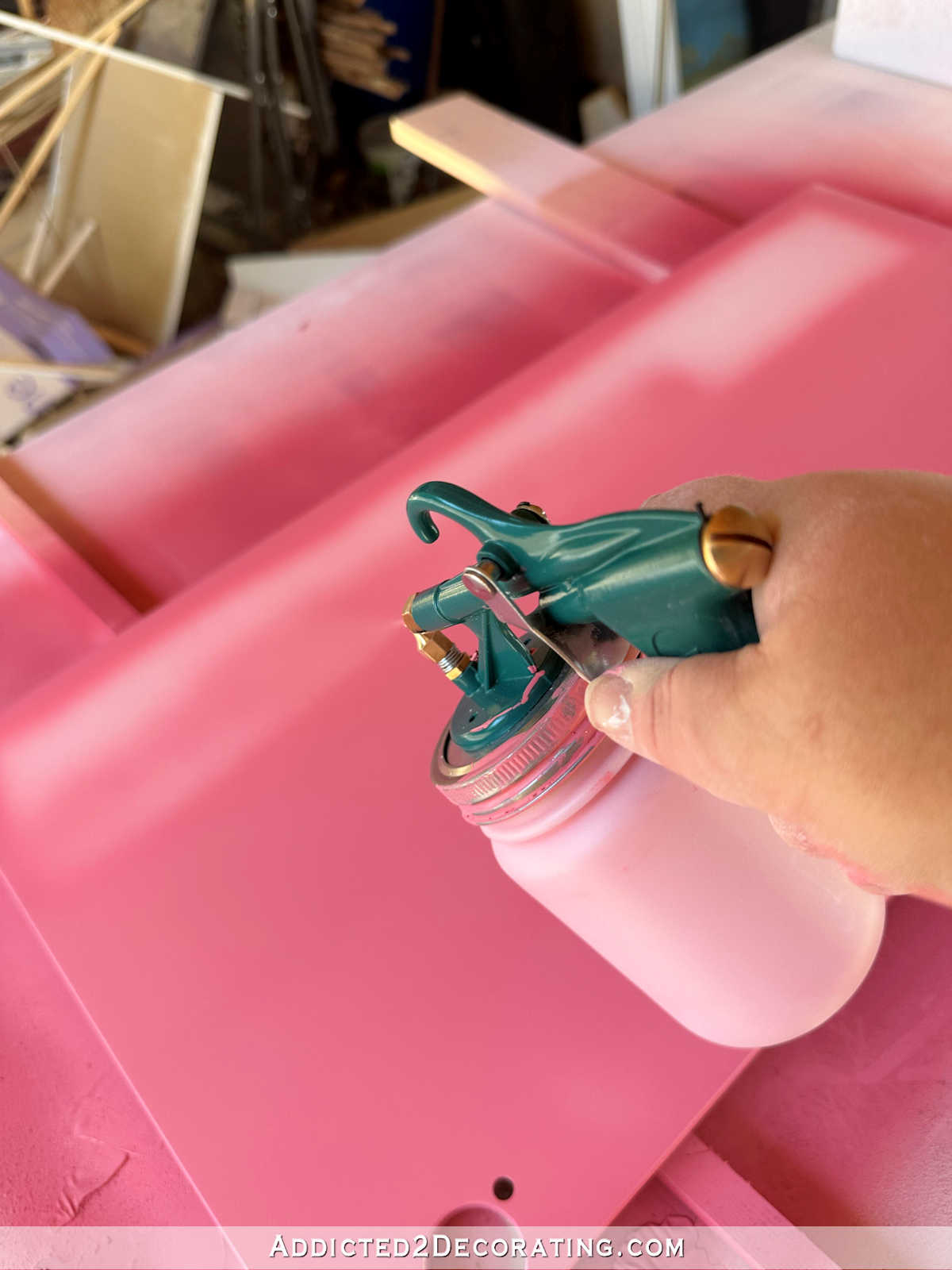
The floor looks wonderful. I like your choice of colors with the quiet contrast. Lovely! And executed so nicely.
My thoughts exactly.
That floor looks lovely. I admire your patience for something like this 🙂
You have done so many wonderful things, but I think this is my favorite. I would like to paint over the laminate floor in my kitchen. It is small and, in my mind, rather ugly. You have inspired me~
I did not remember that you were replacing the wall paper. What are you doing to do with the wall?
I’m replacing it with the same design, but I tweaked the colors some (so that the dark purple flowers actually looked like flowers and not dark purple blobs), and I’m having the design printed larger so that the flowers are about double the size.
It looks amazing! I can’t believe there’s that much contrast because when I saw the base gray color against the cabinets, it didn’t look that contrast-y. Great tips, too!
I love the floors. I thought they were going to be black and white and I just couldn’t see that so I was so pleased that they are not black and white. You work to hard on all your projects. What motivates you to get up every day and work? I get a hundred projects going and nothing finished before I am starting another project. So soon my sewing room is a mess. I have bins of fabric everywhere. And you, my dear, get up and work.
You have done a wonderful job on the floors, well on everything you do. Keep up the good work.
Right now, I’m solely motivated by the fact that this is the last room in our home. I’ll have other projects that I want to go back and address in rooms that have already been finished, but that’s just normal homeownership. But as far as actual remodels, this is the final room (until we do our addition). And I’m so excited about having a house where all of the rooms have been remodeled, and finally not having any huge projects hanging over my head.
I’m also really determined to get this room done by our 10-year anniversary of buying this house, which is mid-August. I have no idea if I can actually finish it by then, but I’d love to try!
Another great way to remove pencil marks is Windex. The original kind with ammonia (window cleaners w/o ammonia don’t work). This works best when the pencil marks are relatively new and fresh. I prefer that over the magic erasers, but do use those if the marks are stubborn. The floor looks great!
Looks great and as always, excellent instructions for the rest of us. I especially liked the tip about using a Magic Eraser, I usually use a white vinyl eraser but I’ll give that a try.
Kristi, I recently read the trick to using that paint masking tape, and I am sure it is exactly what you are saying, but to tell the truth, I cannot understand it. You paint the edge ahead of time so that it doesn’t bleed under the tape? But can’t it still bleed when you do that action? I have given up on tape long ago because it never worked well. Now, I still don’t understand how you get the great results. ???
Yes, it can, and probably does, still bleed under the tape. But it doesn’t show. I painted the whole floor Classic Gray, and then put the tape on, and sealed it with Classic Gray. So if any of it bleeds under the tape, it won’t show. But it does seal the tape, and then I can go back over it with the contrast color. As long as the tape is being sealed with the first color and not with the contrast color, it won’t show, and the result will be perfect lines.
Love the end result and the great tip to alleviate the bleed through along the tape line.
It’s beautiful. Your attention to detail is just amazing.
It’s beautiful Kristi!! Your vision is becoming reality – at last.
Wow, it looks gorgeous! You are amazing, Kristi. This is one of my favorite projects from you. I especially like that the contrast is soft, not harsh.
It’s beautiful Kristi! I can’t wait to see more progress
It’s beautiful Kristi! I can’t wait to see more progress. Well done
Stunning result! So well thought out!
Oh Kristi, that is fab-fab-fabulous! And I’m now more than ever in the no border camp; that floor is a vista! I do hope your back and knees are OK after this is finished. That’s a lot of time bent over and kneeling.
Wow! Impressive!
It’s so pretty!!! I really can’t say how much I LOVE this floor!!! You probably could use a massage after that job. And a milk shake! 🙂
The floor looks great! And thanks for the magic eraser tip.
Aww you ripped down your beautiful wallpaper.
Wow! This is impressive!!! You make it sound so simple. 💕 Love the floor.
Looks amazing! I’m always impressed with your creativity and style!
Kristi, you are a creative genius. LOVE.THAT.FLOOR!! Your home is so beautifully curated. No detail is overlooked. After all these years, I still can’t wait to see the next project, & the next, & the next…
It looks amazing!
Because I’m too detail-oriented for my own good . . .
1) Did you wet the Magic Eraser as advised on the packaging or use it dry?
2) Did you put the second coat of white on each marked square and immediately remove the tape or put the second coat of white on ALL marked squares and then remove the tape in the same order as you applied the paint?
3) If latter, how did you work on each square without stepping on wet or damp paint?
4) If cure time is 30 days, how is it safe to cover the painted section of floor with paper and move your heavy tables and gear onto it?
5) What kind of paper do you use to cover the floor?
I have looked this up again today to see if you used a top protective coat on your checkerboard studio floor. You didn’t….so that’s all I needed to know. I just finished my expensive outdoor she shed floor…copying your checkerboard design, and it looks good. Then I got to thinking about how the paint would hold up with my moving things around there all of the time. I’m glad I re-read your blog on this.